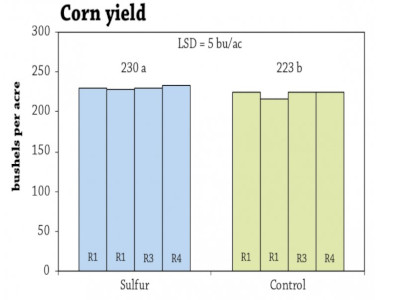Background
Sulfur deficiencies have been documented since about 2005 in corn in Iowa.[1,2] It is thought that deficiencies arose at that time as a result of decreasing air pollution which reduced deposition of atmospheric sulfur. Symptoms of sulfur deficiency include yellowing of new leaves in the whorl with lower leaves maintaining a uniform green coloration.[3] However, identifying sulfur deficiency is tricky because symptoms resemble nitrogen deficiency, and neither soil nor plant tissue tests for sulfur deficiencies have been calibrated for Iowa crops.[1,3] On-farm strip trials are a reliable and straight-forward way to determine if corn in a given field would benefit from sulfur fertilization.
Methods
Design
To determine the benefit of sulfur fertilizer to his corn yield and profitability, Jack Boyer compared two treatments:
- Sulfur (20 lb/ac);
- No sulfur (control)
After soybean harvest in 2019, Boyer planted a cereal rye cover crop on Oct. 29. On Nov. 5, Boyer broadcast 101 lb/ac of potash (0-0-60) and 29.7 lb/ac of 12-40-0-10S-1Zn, resulting in a total addition of 3.5 lb N/ac, 12 lb P/ac, 60 lb K/ac, 3 lb S/ac and 0.3 lb Zn/ac.
Boyer planted corn on April 26, 2020, 20 days after knifing in anhydrous ammonia at a rate of 150 lb N/ac (April 6). Corn was planted in 30-in. rows at a population of 34,000 seeds/ac. On May 4, one week after planting corn, Boyer terminated the cereal rye cover crop and applied 30 lb N/ac as UAN(28) with a tank mix of Roundup Powermax (44 oz/ac) and HarnessXtra (48 oz/ac).
On the same date of terminating cereal rye, Boyer established treatment strips by broadcasting sulfur at a rate of 20 lb S/ac (12-0-0-26S, 77 lb/ac) in only the sulfur strips. This product added an extra 9 lb N/ac to the sulfur strips compared to the control strips. Additionally, this application was added to the termination tank mix and did not require an extra pass. Boyer randomly arranged treatment strips side-by-side in a randomized complete block design (Figure A1). Strips measured 30 ft by 2,450 ft and treatments were replicated 4 times for a total of 8 strips.
Measurements
Boyer harvested corn and recorded yields from individual strips on Oct. 28, 2020. Yields are reported at standard moisture (15.5%).
Data analysis
To evaluate the effect of sulfur fertilizer on corn yield, we calculated the average yield for both treatments then used a t-test to compute the least significant difference (LSD) at the 95% confidence level. The difference between average yields is compared with the LSD to determine if the treatment yield is statistically different from the control yield. A difference greater than or equal to the LSD indicates the difference in yields is statistically significant, meaning Boyer can expect the same results to occur 95 out of 100 times under the same conditions. A difference that is less than the LSD indicates the difference in yields is not statistically significant.
Results and Discussion
Corn yields
Averaging 230 bu/ac, corn yield in the sulfur treatment was statistically greater than in the control treatment (223 bu/ac). Yields in both treatments exceed the 5-year average for Grundy County (210 bu/ac)[4].

FIGURE 1. Corn yields at Jack Boyer’s, harvested on Oct. 28, 2020. Columns represent yields of individual strips. The average yield is indicated above each group of columns. Because the difference between the two averages (7 bu/ac) is greater than the least significant difference (LSD = 5 bu/ac), the treatment yields are considered statistically different at the 95% confidence level.
Economic considerations
The return on investment for the sulfur treatment was only $3.04 greater than for the control treatment (Table 1). The cost of the sulfur fertilizer application was not included in the partial budget because it was tank mixed with the cereal rye termination herbicide, which occurred in both treatments.

Click here to see more...